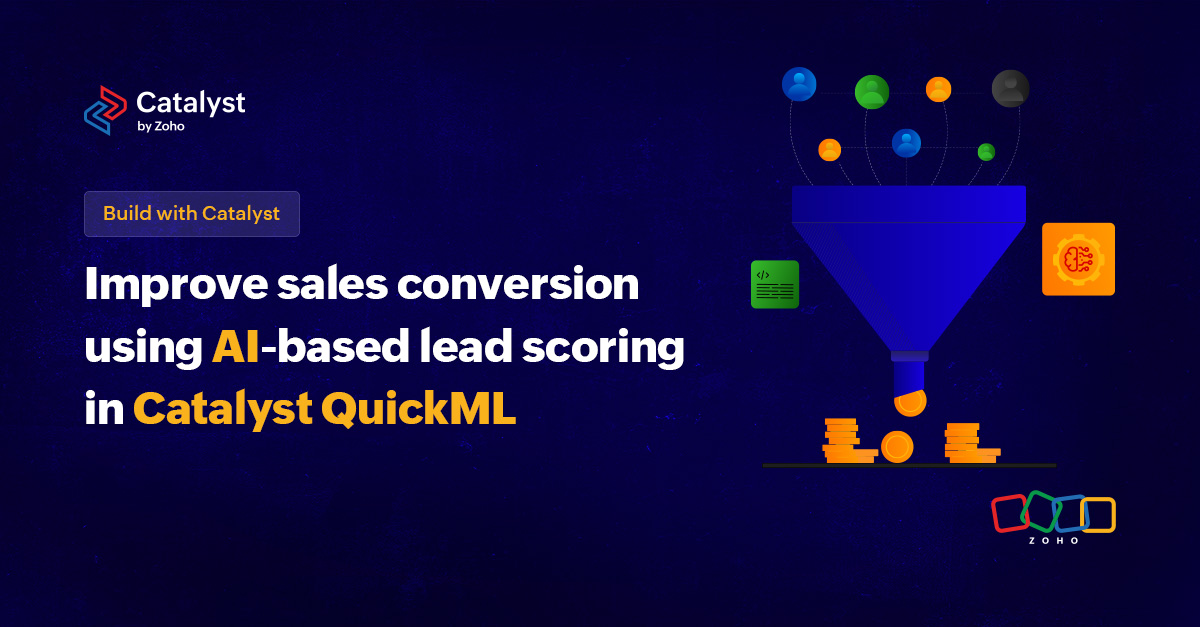- HOME
- Build with Catalyst: Improve sales conversion using AI-based lead scoring in Catalyst QuickML
Build with Catalyst: Improve sales conversion using AI-based lead scoring in Catalyst QuickML
- Last Updated : October 10, 2023
- 321 Views
- 3 Min Read

We are thrilled to start a weekly series called Build with Catalyst, where we dig into various business use cases to understand how Catalyst services can help serve you better. The use cases we'll cover fit your business needs and help you understand the depth of the applications built on Catalyst. Today, we cover an interesting use case using QuickML, our no-code platform, to build ML-powered models for your custom business needs.
Let's say your customer runs a HVAC (Heating, Ventilation, and Air Conditioning) solution. Traditionally, sales leaders chase an extensive list of leads, and sales teams work on leads without any prioritization leading to poor conversions. In this case, how would the sales head monitor thousands of leads from different parts of the country in a day? Will it not be helpful if the leads are categorized based on historical trends of company data as :
High potential, Good probability
High potential, Low probability
Others
Adding intelligence to your sales operation can drastically improve conversions with minimal effort. Predictive lead scoring using QuickML facilitates harnessing the power of historical data and predict a lead's conversion chances, using any of the 20+ parameters from a company's historical data. Furthermore, the customer can select the weightage for each parameter and fine-tune the ML model.
For example, let's say that historical trends suggest that leads coming from educational institutions in the Alabama region have very poor conversion rates. It could be due to multiple factors like non-exclusive distributors, poor competence of regional sales in that industry, or even aggressive competitors. Leveraging QuickML, you could analyze the historical data and delve deeper into why the conversion rates are low in the Alabama region and take necessary actions to combat them.
Predictive lead scoring empowers the sales team with in-depth prospect knowledge and helps target leads based on priority—resulting in better conversions and a higher revenue stream. You could quickly build one in QuickML in just a few simple steps:
Upload the lead dataset to QuickML. Based on the multiple user attributes, such as industry, deal size, lead source, city, time spent on the website, or other socio-demographic data, using QuickML, you could analyze the data and pinpoint the influential elements that are driving sales conversions and those which aren't.
Build a pipeline to produce a model based on the analysis. The model created will exhibit accuracy based on the data quality passed to the algorithm.
Establish an endpoint using QuickML when the model is ready. This endpoint will provide a REST API.
Import the previous day's leads into the Catalyst App and invoke the endpoints generated in Step 3 to accurately predict the conversion chances for each lead.
Use Catalyst Functions to classify each of the leads into logical categories like "High potential-Low probability", "High potential-High probability", and "Others".
Create a report as an email and push it to the decision makers.
The sales heads can now easily prioritize their tasks and focus their efforts on the "high-impact" category leads, with the intelligence on what interventions could help them close leads better. Staying on top of your sales conversion strategy is now easier with the powerful combination of:
Catalyst QuickML
Catalyst FaaS
We'd love to hear about your journey with Catalyst QuickML. Put on your creative hat, play around with Catalyst, and share possible use cases with QuickML. Feel free to share your thoughts in the comments section or drop us a line at Catalyst for a detailed 1:1 session to help you get started. Watch out for the next post on SmartBrowz this week, where we'll cover another compelling use case.